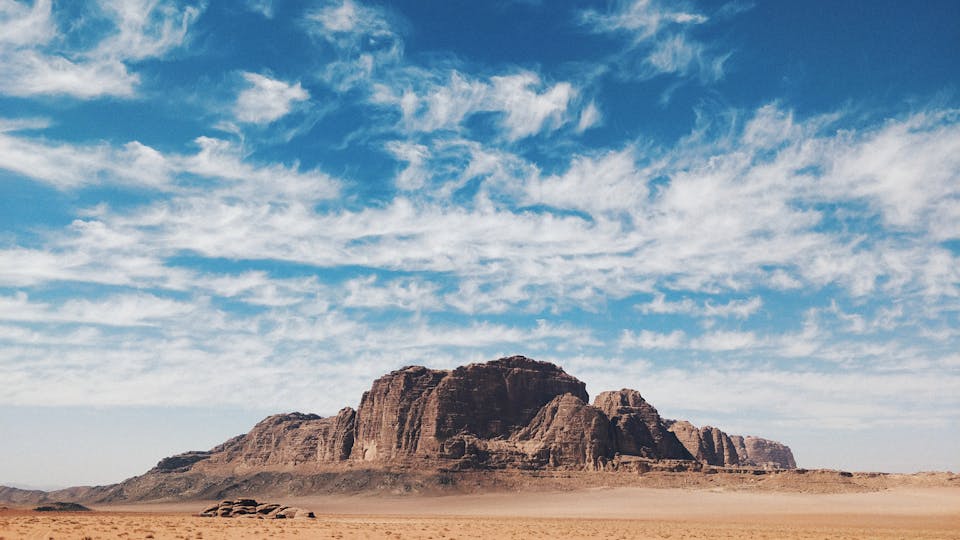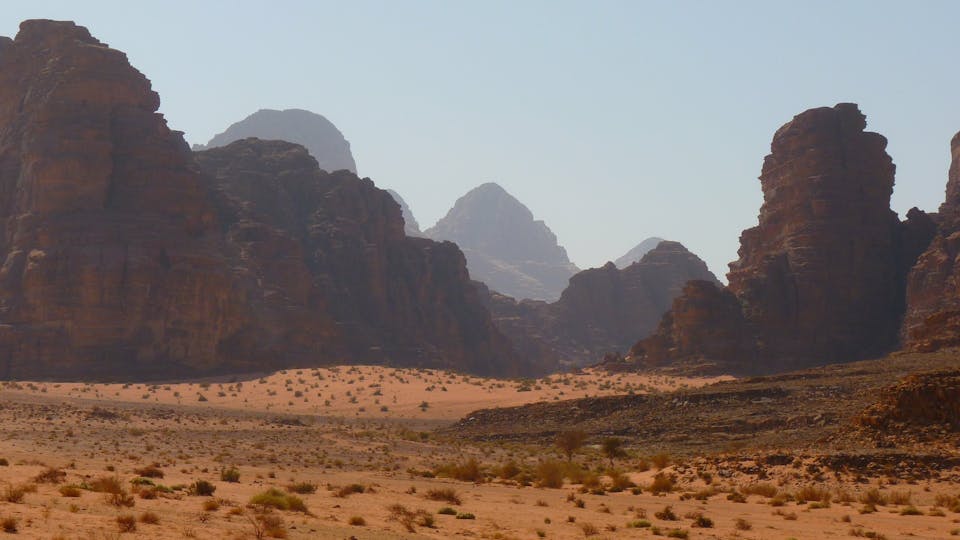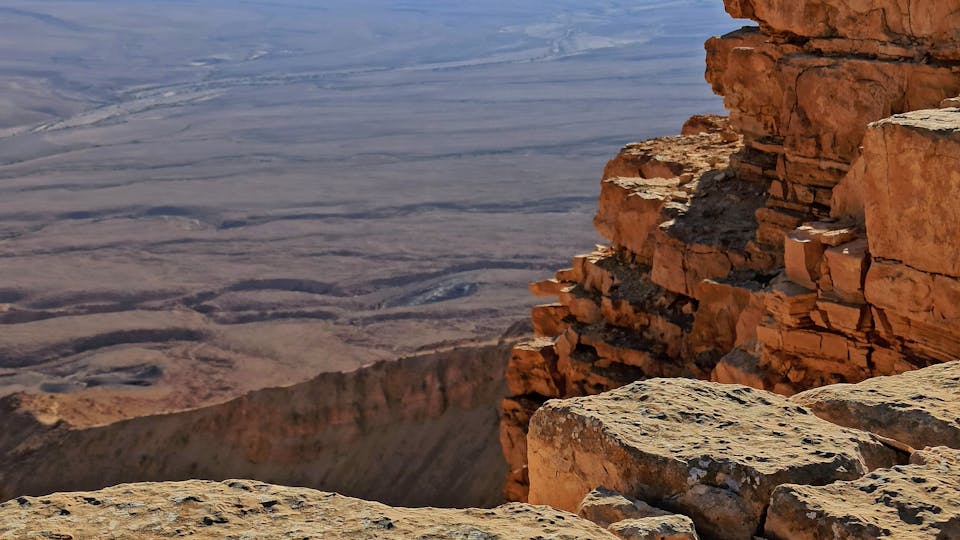Where is The Biblical Mount Sinai? - CH
Why is Mount Sinai so Important?
Mount Sinai, the secluded and mysterious rocky peak where God gave mankind the Ten Commandments, is located somewhere among the remote sand dunes and rugged mountain terrains of the Middle East is. Since the time they were given, these “ten pearls of respect,” as we often refer to them here in Israel, formed the backbone of every civilization that was to leave a positive mark on humanity. Respect God… respect His name… respect His day… respect your mother and your father… respect the truth… respect your neighbor… respect your neighbor’s wife… respect your neighbor’s stuff… respect yourself.
These ten foundational principles were given to the children of Israel as they emerged from extended slavery and hardship in the land of Egypt, forming the essential moral spine of the new nation that God called “Ami,” meaning “My Nation” in the Hebrew language. According to the divine plan revealed hundreds of years beforehand to Father Abraham, now was the time to launch a new movement in the earth; to birth a nation whose calling was to be “A kingdom of priests and a holy nation” (Exodus 19:6). This nation’s mission was to shine the light of God’s revelation and salvation to the pagan nations dwelling in a darkened world.
The record of Israel’s biblical history offers an honest depiction of the struggles, and many failures, of God’s people. Still, God’s testimony and work through the people of Israel shined brightly for thousands of years as they served as an example (both good and bad example…) to other nations, all the way to Israel’s rebirth in our time. And central to Israel’s historic calling and purpose were the events that unfolded at Mount Sinai nearly 3,700 years ago, namely the covenant that was confirmed between God and His people, a covenant that was predicated on the Law of Moses, the “Torah,” which means the “instruction.”
The Laws of Moses at Mount Sinai
According to rabbinic understanding, the “Torah”, or “Instruction” that was given by God to Moses to hand down to Israel at Mount Sinai included 613 rules and regulations addressing everything society needed in order to be successful. These “rules for a blessed life” included family dynamics, honest business principles, personal hygiene, diet, social structure, education, government, national holidays, and of course prayer, worship, and sacrificial services to God.
A special and elaborate Tabernacle was erected in the heart of the national camp of Israel’s 12 tribes called the “Tent of Meeting,” where God met the national leaders face to face, and where most of the sacrificial practices took place. The laws and regulations were written down and carefully preserved from generation to generation, and an honest review of Israel’s biblical history clearly points to the sad fact that the nation’s repeated struggles and failures were always a direct consequence of forsaking God’s instructions.
And so, Mount Sinai represents a historic and epic reminder of God’s original calling for the nation of Israel. As in the biblical account, the dramatic images of God’s consuming fire upon the mountaintop and His thundering voice shaking the rocks still resonate throughout Israel’s national mindset, reminding the people of their original, and some say impossible national calling. But, can we find the actual location of Mount Sinai today? Were scholars and researchers able to geographically pinpoint Mount Sinai which is also called the Mountain of God, Mount Horev, or Jabal Mūsā in Arabic?
And while research points to various possible locations for the biblical Mount Sinai, we shall consider here the three most known and documented options.
1. Mount Sinai in the Sinai Peninsula
No doubt, the most “famous” location for Mount Sinai is a gigantic granite peak at the south-central region of the Sinai Peninsula between Israel and Egypt which rises to 7,497 feet (2,285 meters) above sea level. And even though scholars differ as to the exact route the Israelites took during their Exodus from Egypt, this location has long been accepted as the actual site by many scholars of the main faith traditions including Judaism, Christianity, and Islam.
Pilgrims, scholars, and hermits have frequented this site extensively for thousands of years, with the earliest recorded visits of Eusebius of Caesarea during the 4th Century AD, and Egeria’s pilgrimage during her 381 – 384 AD travels in the region. During the early Messianic / Christian era the region was often visited by mystics and pilgrims seeking spiritual enlightenment (possibly including Paul the Apostle), and the famous Monastery of St. Catherine was built at the foot of the mountain in 530 AD. Maintained by the Orthodox Church of Mount Sinai, this is possibly the world’s oldest continuously inhabited Christian monastery containing a library of ancient manuscripts which included a 4th Century Greek Codex Sinaiticus of the Bible (which was moved to the British Museum).
Many of our Sar-El groups visit this site during their Holy Land pilgrimages, and their experience is always a profound one.
Jewish Views of Mount Sinai
Contrary to Christian traditions, the Jewish views regarding the exact location of Mount Sinai are quite vague. In fact, once the Torah, the Law of Moses, was given to Israel on Mount Sinai, there is only one more biblical mention of the mountain in the book of 1-Kings chapter 19 which describes how the prophet Elijah, when escaping from evil Queen Jezebel, found refuge in a cave on the slopes of “Horev, the mountain of God,” which is identified as Mount Sinai.
In Elijah’s account, the mountain is, once again, the site of a great ecological drama including fire, storm, and an earthquake, only this time God reveals to the prophet that He doesn’t dwell in these outward powerful manifestations, similar to the dramatic events of the receiving of the Law, but rather that He can be found in the stillness of the inner human spirit. Contrasting the powerful displays which accompanied the receiving of the Law at Mount Sinai, now God is revealing Himself to His servant the prophet, at the very same mountain, through a still small voice that can only be heard in the human heart.
Rabbinic teachings at the Talmud conclude that “It is not the place that honors the person; rather, the person honors his place, as we found with regard to Mount Sinai, that as long as the Divine Presence rested upon it, the Torah said: ‘Do not let the flocks or the herds graze before that mountain.’ But, once the Divine Presence departed from the mountain, the Torah said: ‘When the shofar sounds long, they may come up to the mountain,’ indicating that the sanctity was not intrinsic to the place, but was due to the Divine Presence resting there.”
This rabbinic teaching hints to the reason why Mount Sinai’s actual location does not hold a prominent place in Jewish traditions since the mountain itself was not inherently important or holy, but rather God was, who inhabited the mountain during the giving of the Law. The events that took place at Mount Sinai made it holy, but once the Torah was given and the covenant was established, Mount Sinai was just another mountain.

2. Mount Sinai in Saudi Arabia
While researchers and scholars have identified different sites as the possible locations of the “real” Mount Sinai, the idea of the mountain being located in the land of Midian (modern-day Saudi Arabia) is not new. Of the various locations proposed, Charles Beke suggested Mount Baggir to the North East of the Gulf of Akaba, Alois Musil and H. Philby point to Jebel al-Manifa near Wadi al-Hrob, and a French scholar, Jean Koenig, has proposed the volcanic peak of Hala’l bedr.
However, perhaps the most “popular,” though contested, is the work of the late Ron Wyatt who added a fourth Midianite possibility, Jebel al-Lawz. This same American researcher also claimed to have discovered the locations of Noah’s Ark, Sodom and Gomorrah, the Red Sea crossing, the Ark of the Covenant, and other biblical archaeological treasures.
Wyatt’s assumption that Mount Sinai is located in the ancient Land of Midian is based on his understanding of the text of Exodus 3:1. He assumed that because Moses kept Jethro’s flocks (Jethro was a priest of Midian), that meant that the mountain of God that Moses came upon must also be in the land of Midian.
After claiming in 1978 to have discovered the Red Sea crossing at Newaba in the Gulf of Akaba (the eastern branch of the Red Sea), Wyatt concluded that the real Mount Sinai must be located east from the path of the miraculous Red Sea crossing, in the territory of western modern-day Saudi Arabia. The best possibility, Wyatt thought, was Jebel al-Lawz, because it presented the highest peak in the entire western Saudi Arabian mountain range. In 1984 Wyatt and his two sons illegally crossed into Saudi Arabia to explore and photograph the area, but they were captured, their films confiscated, and they actually were jailed for 78 days by the Saudis as Israeli spies.
Wyatt later returned to Saudi Arabia legally on a mission of “treasure hunting,” looking for the “Mountain of God” as well as for Egyptian treasures hidden in the region and the leftovers of Pharos’ huge army which he believed could be found at the bottom of the Red Sea. Subsequent delegations and researchers followed in the coming years, producing impressive results, yet, as most scholars agree, these are still speculative and lack definitive and indisputable archeological proofs.
Wyatt’s research points to a large pile of granite rocks about a quarter of a mile from the base of the mountain with petroglyphs of bovine (bulls, cows, and oxen) on it. Quoting a Saudi archaeologist from Riyadh University as saying that these were Egyptian-style cows and bulls who had never been found anywhere else in Saudi Arabia, Wyatt surmised (though it was later questioned by other scholars) that this was the great altar of Israel at the foot of Mount Sinai in Saudi Arabia, and possibly the one mentioned in the Golden Calf story.
Wyatt’s also pointed to what he believed were remnants of pharos’ chariots found at the bottom of the Red Sea facing Jebel al-Lawz; a blackened mountaintop (indicating the fire of God); a massive split rock with the appearance of a powerful water flow; 12 stone pillars located below the mountain; and other findings which he related to the biblical narrative of the Mount Sinai events.
The Split Rock at Mount Sinai in Saudi Arabia
Deuteronomy 9:21 says that there was “a brook that descended from the mountain” into which Moses scattered the ashes of the golden calf that he burned down after he descended from Mount Sinai with the tablets of the Ten Commandments. Researchers of the Saudi Arabia site found the markings of a large water flow snaking down the mountainside which appear to start from nowhere.
They claimed that this ancient watershed which is filled with large water-polished boulders is clear evidence of a fast-moving strong stream that came out of a rock and carved its path down the mountainside. In an arid landscape, this was the miracle they were looking for, and finding a large rock that seemed to be split apart in the middle, they suggested that it could be the rock that Moses struck to bring out water for the thirsty nation (Exodus 17:6 and Psalm 78: 15-16).
Could this be sufficient evidence to validate the claim that this is the location of the “real” Mount Sinai? Many scholars argue against this assumption, claiming that mere photographs are not enough evidence to establish the case and that a team of geologists must examine the rock closely to verify the researchers’ claim. Further, while it is true that the region is classified as an arid desert, it does receive roughly 100 mm (4 inches) of rain per year; heavy rains that mostly come in the form of tropical monsoons often create flash floods sufficient to polish these rocks.

Pharos’ Army Destroyed in the Red Sea
Wyatt’s assumption that the Israelites crossed the Red Sea at Neweba (a famous Red Sea resort today) into western Saudi Arabia is supported by his understanding of the surrounding terrain, the narrow canyon-like pathway leading to a broad beachfront plateau surrounded by steep mountains (a perfect trap), and the fact that the Red Sea facing that coastline is relatively shallow. His research also pointed to what he believed were chariot fragments crystalized at the bottom of the Red Sea.
According to the biblical text, Pharaoh’s elite force of 600 chariots plus his regular chariots (Exodus 14:7- 9, and 28), cavalry, and infantry army were destroyed at the Red Sea. Josephus Flavius, the First Century historian, wrote in his book “Antiquities” that in addition to the chariots, an Egyptian military force of 50,000 horsemen and 200,000 infantry were also destroyed when the Red Sea closed in on them. It was because of the great power of that miraculous deliverance that the sons of Israel “feared and believed” God (Exodus 14: 31), while the Philistines, Edomites, Moabites, and Canaanites “trembled and melted away” (Exodus 15:14-16 and Joshua 2: 10).
Difficulties regarding the Saudi Arabian Site
Disputing Wyatt’s assumptions of Mount Sinai’s location in western Saudi Arabia, many scholars argue that Mount Sinai must be located outside of the ancient territory of the Land of Midian. Their questions are based on the text of Exodus 18 which tells us that Jethro, Moses’ father-in-law, came with his family to visit Moses while they were camping at “the Mountain of God.”. Exodus 18:27 tells us that following this visit Moses let his father-in-law depart and that Jethro went back on “his own way to his own land” (Midian), therefore placing Mount Sinai away from the Land of Midian.
In addition, some biblical scholars suggest that the Apostle Paul, while teaching the Galatian Christians about God’s covenants, indicated in Galatians 4:25 that Mount Sinai was in Saudi Arabia (the Land of Median), which seems to support Wyatt’s claims. Yet in the actual text, Paul only says that Mount Sinai is in Arabia, not Saudi Arabia. The fact is that the Galatian's reference could be used to support the notion that Mount Sinai is in Saudi Arabia only if the Apostle was looking at a modern political map. But, it would not be so if he was looking at a First Century Roman map since, according to ancient travel records, the landmass of Arabia in Paul’s time included the Arabian Peninsula as well as the Sinai Peninsula and northern Egypt.
Egeria, the famous 4th Century AD Christian pilgrim to the Holy Land, also visited and documented her travels to Mount Sinai (Jebel Musa) and the Land of Goshen in Egypt. She wrote of Goshen that the region is called "the land of Arabia, the land of Goshen … a region which, while it is part of Egypt, is a great deal better than any of the rest.” What she said, in effect, was that Goshen was located in the general territory of Arabia, showing that ancient Arabia stretched far west from the modern-day Saudi Arabian borders.
Therefore, when the Apostle Paul wrote that Mount Sinai was in Arabia, he was referring to the First Century view of the region, placing Mount Sinai somewhere in the Sinai Peninsula which was part of Arabia at the time.
Questions Regarding the Wilderness Journey
Deuteronomy 33:2, Judges 5:4, and Habakkuk 3:3 all state that Seir, Mt. Paran, and Teman are located in the territory of Edom which is presumably on the eastern side of the Aravah, the arid territory that stretches between the Dead Sea and the Red Sea. Yet, a careful examination of the Scriptures places the territory of Edom on both the east as well as the west side of the Aravah (Numbers 34: 3 and Joshua 15:1). This area is considered the Central Negev Highlands today, and if this were the case, then the locations of Seir, Mt. Paran, and Teman fit into the modern-day Central Negev in the State of Israel, or the northeast neighboring Sinai Peninsula.
Since some scholars associate Mt. Paran with the biblical Kadesh Barne’a, Seir with the Jebel-es-Se’ira, and Teman with the area of Kuntillet ‘Ajrud (where the inscriptions “Yahweh of Teman” were found), then the above passages actually refer to the Lord leading the Children of Israel for 40 years throughout the northeastern part of the Sinai Peninsula and not in Saudi Arabia at all.
Another important question regarding the Saudi Arabian location for Mount Sinai is the statement by Moses that Mount Horev (another name for Mount Sinai) was “eleven days journey from Kadesh Barne’a” (Deut. 1:2). In other words, it would be quite impossible to imagine two or three million Hebrews journey on foot with children and livestock through rough terrain from Jebel el-Lawz in Saudi Arabia to the Kadesh Barne’a location in southern Israel in just eleven days.

3. "Mountain of Saffron" – Mount Sinai in the Israeli Negev
A third, not as known yet extensively excavated site claiming to be Mount Sinai’s location, is found in the region of the southwest Negev desert in Israel, between Petra and Kadesh Barne’a. Named “Har Karkom” in the Hebrew language, or “Mountain of Saffron,” the scholars leading this study base their case on the premise that the ancient Israelites crossed the Sinai Peninsula towards Petra in a fairly straight line which led them to “Har Karkom,” the Negev Mountain they claim is the Biblical Mount Sinai.
The teams excavating and researching this mountain discovered evidence of rich religious activities all across the large surrounding plateaus including shrines, altars, stone circles, stone pillars, and over 40,000 rock engravings!
Based on these and other local findings, the Israeli researchers suggest the identification of “Har Karkom” as the biblical Mount Sinai, even though the height of the discovered religious activity at the site date older than the time of the Exodus from Egypt that is traditionally dated between 1600-1200 BC. To compensate for that time lag, the Israeli researchers placed the Exodus from Egypt earlier, between 2350 – 2000 BC, citing other archaeological evidence to support their hypothesis.
Such “revisionist chronologies,” though not new, are often frowned upon and rejected in scholarly circles. One such early rejection of the “Har Kardom” claim argues that the type of Early Bronze Age religious items and structures discovered at the site have also been found in significant numbers in other locations in the Negev and Sinai regions, disproving their uniqueness to this site.
Further objections to the “Har Karkom” theory is linguistic, raising the question that if this mountain indeed marks the actual place and time where Israel received the stone tablets with the Ten Commandments written on them, then in what language would they have been written? The question is especially critical since the Canaanite alphabetic script (from which the Hebrew script developed) was still developing in and around 1800 BC, hundreds of years after the alleged religious activities appeared by “Har Karkom.”

What does it mean to today’s pilgrim?
Wherever the actual site of Mount Sinai is, it seems the Lord has not provided indisputable archeological proofs as is the case of other biblical sites whose location is positive such as the City of David, Temple Mount, Nazareth, or Capernaum. The reason for the archeological uncertainty and scholarly vagueness surrounding the location of the biblical Mount Sinai may be found in the New Testament tradition which points the eyes of the believer away from Mount Sinai (resembling the Old Covenant) and toward Mount Zion (symbolizing the New Covenant).
Christian Pilgrims to the Land of the Bible will remember the Apostolic instruction recorded in the letter to the Hebrews chapter 12, saying, “For you have not come to the mountain that may be touched and that burned with fire, and to blackness and darkness and tempest, and the sound of a trumpet and the voice of words, so that those who heard it begged that the word should not be spoken to them anymore… And so terrifying was the sight that Moses said, ‘I am exceedingly afraid and trembling.’ But you have come to Mount Zion and to the city of the living God, the heavenly Jerusalem…”
As you plan your next visit to Israel, let our Sar-El team of experts suggest how you may include a fascinating visit to any of those possible sites of Mount Sinai to re-discover and re-live those timeless events. Such visits will, without a doubt, add spiritual depth and biblical value to your experience in the Holy Land.
We are looking forward to hearing from you.
Your Sar-El Tours team.